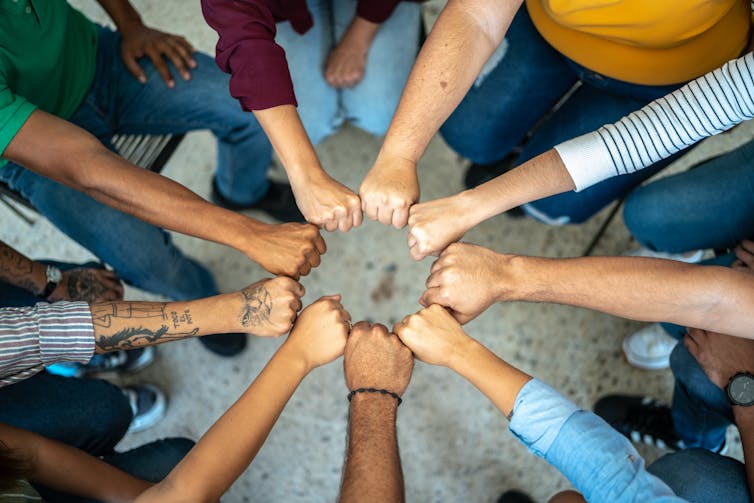Prominent politicians have recently increased their attacks on workplace programs that promote diversity, equity and inclusion, or DEI. They claim that initiatives that seek to be inclusive are divisive and lack merit.
President-elect Donald Trump has vowed to ban DEI from federal offices. And Vice President-elect JD Vance, an Ohio senator, in June 2024 introduced the “Dismantle DEI Act” to eliminate all DEI programs from the federal government. He argued, in part, that DEI “breeds hatred and racial division.”
DEI critics are increasingly using the term “diversity hire” as an insult. As a scholar focused on gender and exclusion, I recognize that these attacks are often rooted in anti-Black racism.
For example, despite Kamala Harris’ achievements as vice president and California attorney general, some Republicans targeted her as a “DEI hire” during her recent presidential run. And after the Francis Scott Key bridge collapse in Baltimore in March 2024, Utah State Representative Phil Lyman blamed Wes Moore, Maryland’s first Black governor, for prioritizing DEI over security.
The DEI backlash has hit corporate America, too. Companies like spirits-maker Brown-Forman and the farm equipment manufacturer John Deere have reversed the DEI commitments they made following the 2020 murder of George Floyd by a white police officer.
I believe all these attacks, both political and corporate, promote a distorted and incomplete story about DEI.
The empirical evidence is clear
There is no one-size-fits-all approach to advancing DEI initiatives. The common goal is to create spaces within an institution where everyone feels valued and respected and can thrive.
A 2020 Gallup poll found that 24% of Black and Latino employees have experienced discrimination at work, compared with 15% of white employees.
DEI efforts to identify and solve such issues include surveys, employee interviews and comparing practices across different organizations. They also entail assessments of systems, policies and research, and developing initiatives to address areas that need improvement.
Employee and student surveys, for example, can measure the sense of belonging within an organization and help leaders identify areas in need of improvement.
Evidence suggests that successfully implementing DEI is central to professional and societal well-being and success in a multicultural society.

AP Photo/Mark Schiefelbein
Recent research by the author Melinda Epler, for example, shows a clear connection between employees’ sense of safety, belonging and satisfaction and how much their employer prioritizes DEI. Scientists also find that diversity is key to creative, productive and efficient scientific teams.
And other research indicates that employees are more innovative and work harder when teams are made up of people with different experiences. This is why many employers value employees who can solve problems while working with people who have diverse backgrounds in terms of race, gender, religion, age and other factors.
The outcome can be lucrative for companies: On U.S. and global executive staffs, studies show, efforts to improve DEI result in increased profits. Companies with at least one woman on their board, for example, financially outperform those with only men on their boards.
Diversity standards
Despite the many ways leaders of an organization can work to cultivate an inclusive and respectful culture, DEI critics tend to portray this work in simplistic terms.
For example, two Stanford University academics misrepresented DEI efforts recently. In an August 2024 op-ed in The New York Times, they presented DEI as mainly consisting of one-time trainings that divide groups into oppressors and the oppressed.
Narrowly defining DEI in such simplistic ways ignores the bridge-building involved in DEI efforts and makes it easier to repeat the single story that DEI has failed.
In her 2009 TED Talk on the danger of the “single story,” novelist Chimamanda Adichie said single stories, or narratives that only present one perspective, are based on stereotypes and incomplete information. They result in false assumptions and generalizations.
“To create a single story is to show a people as one thing, as only one thing, over and over again,” Adichie said. “And that is what they become.”
Adichie’s warnings about the single story sheds light on the effects of attacks on DEI. Reducing DEI to simplistic “us vs. them” approaches or to a focus on “oppressor vs. oppressed” misses much of the work.
Yet the more societal problems Republicans in power blame DEI for – from racism to inflation – the more believable the story of DEI failure becomes. The absence of quick, easy solutions for historical racial and socioeconomic inequities are presented as further proof of DEI’s failure.
Teaching a fuller story
DEI is not easy to do well. But as a DEI practitioner and scholar, I find working to create inclusive spaces through curiosity, learning and dialogue can be transformative.
The more institutions do to support welcoming, supportive spaces – where people’s differences are respected – the healthier and more successful everyone is as individuals and organizations.
In 2022, my team in the Office of Transformational and Inclusive Excellence developed a Religious Observances and Inclusive Scheduling calendar. We did so to recognize religious pluralism in our university community.

FG Trade Latin/Gerry Images
We followed up with educational posters in 2023. The next year, we launched an educational video series featuring students discussing their religious practices. We partnered with the university’s communications office and athletics office to create and show these videos at university athletic events, such as football and basketball games.
In January 2024, the office I lead at Miami University partnered with several other departments to launch what we called a Constructive Dialogue Initiative. The goal of this new project is to provide all students with concrete skills and opportunities to communicate across social and cultural differences and to decrease polarization. Students first engage with short online modules from the Constructive Dialogue Institute. They then apply strategies learned online to facilitate in-person, peer-to-peer dialogues.
Our pilot program showed very positive results. Among the nearly 100 student leaders who participated, 78% felt less polarized.
This work is important for universities, where research shows retention and graduation rates are tied to students’ sense of belonging.
Collaboration and communication across differences are central to successful DEI efforts.
This is why we launched the DEI in Leadership Certificate in 2022. That same year, the project won an international Telly Award, which recognizes excellence in video.
Those who have participated in the certificate have included leaders and employees in the health, legal, human resources, criminal justice and nonprofit sectors across the U.S.
The narrow, single story of DEI failure promoted by critics makes it very difficult to recognize the value of these efforts.
Simplistic single stories can be appealing. They do not reflect reality, though. The fuller story presents a much more useful way to advance shared goals — as a society that is deserving of systems in which everyone can be included and valued.

Felecia Phillips Ollie DD (h.c.) is the inspiring leader and founder of The Equality Network LLC (TEN). With a background in coaching, travel, and a career in news, Felecia brings a unique perspective to promoting diversity and inclusion. Holding a Bachelor’s Degree in English/Communications, she is passionate about creating a more inclusive future. From graduating from Mississippi Valley State University to leading initiatives like the Washington State Department of Ecology’s Equal Employment Opportunity Program, Felecia is dedicated to making a positive impact. Join her journey on our blog as she shares insights and leads the charge for equity through The Equality Network.




